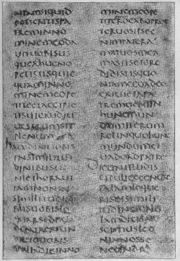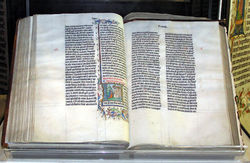Vetus Latina

Vetus Latina is a collective name given to the Biblical texts in Latin that were translated before St Jerome's Vulgate Bible (382-405 AD) became the standard Bible for Latin-speaking Western Christians. The phrase Vetus Latina is Latin for Old Latin, and the Vetus Latina is sometimes known as the Old Latin Bible.[1] It was, however, written in Late Latin, not the early version of the Latin language known as Old Latin.
Contents |
Text
There was no single "Vetus Latina" Bible; there are, instead, a collection of Biblical manuscript texts that bear witness to Latin translations of Biblical passages that preceded Jerome's.[1] After comparing readings for Luke 24:4-5 in Vetus Latina manuscripts, Bruce Metzger counted "no fewer than 27 variant readings!" To these witnesses of previous translations, many scholars frequently add quotations of Biblical passages that appear in the works of the Latin Fathers, some of which share readings with certain groups of manuscripts. As such, many of the Vetus Latina "versions" were generally not promulgated in their own right as translations of the Bible to be used in the whole Church; rather, many of the texts that form part of the Vetus Latina were prepared on an ad hoc basis for the local use of Christian communities, to illuminate another Christian discourse or sermon, or as the Latin half of a diglot manuscript (e.g. Codex Bezae). There are some Old Latin texts that seem to have aspired to greater stature or currency; several manuscripts of Old Latin Gospels exist, containing the four canonical Gospels; the several manuscripts that contain them differ substantially from one another. Other Biblical passages, however, are extant only in excerpts or fragments.
| Part of a series on |
| The Bible |
|---|
 |
| Biblical canon and books |
|
Old Testament (OT) New Testament (NT) Hebrew Bible Deuterocanon Antilegomena Chapters and verses |
| Development and authorship |
| Jewish canon Old Testament canon New Testament canon Mosaic authorship Pauline epistles Johannine works Petrine epistles |
| Translations and manuscripts |
| Septuagint Samaritan Torah Dead Sea scrolls Masoretic text Targums · Peshitta Vetus Latina · Vulgate Gothic Bible · Luther Bible English Bibles |
| Biblical studies |
| Dating the Bible Biblical criticism Higher criticism Textual criticism Canonical criticism Novum Testamentum Graece Documentary hypothesis Synoptic problem NT textual categories Historicity
Internal consistencyPeople · Places · Names Archeology · Artifacts Science and the Bible |
| Interpretation |
| Hermeneutics Pesher · Midrash · Pardes Allegorical interpretation Literalism Prophecy |
| Perspectives |
| Gnostic · Islamic · Qur'anic Christianity and Judaism Biblical law
Inerrancy · Infallibilityin Judaism · in Christianity Criticism of the Bible |
|
· |
The language of the Old Latin translations is uneven in quality, as Augustine of Hippo lamented in De Doctrina Christiana (2, 16). Grammatical solecisms abound; some reproduce literally Greek or Hebrew idioms as they appear in the Septuagint. Likewise, the various Old Latin translations reflect the various versions of the Septuagint circulating, with the African manuscripts (such as the Codex Bobiensis) preserving readings of the Western text-type, while readings in the European manuscripts are closer to the Byzantine text-type. Many grammatical idiosyncrasies come from the use of Vulgar Latin grammatical forms in the text.
Replacement
With the publication of Jerome's Vulgate, which offered a single, stylistically consistent Latin text translated from the original tongues, the Vetus Latina gradually fell out of use. Jerome, in a letter, complains that his new version was initially disliked by Christians who were familiar with the phrasing of the old translations. However, as copies of the complete Bible were infrequently found, Old Latin translations of various books of the Bible were copied into manuscripts alongside Vulgate translations, inevitably exchanging readings; Old Latin translations of single books can be found in manuscripts as late as the 13th century. However, the Vulgate generally displaced the Vetus Latina and was acknowledged as the official Bible of the Roman Catholic Church at the Council of Trent.
Below are some comparisons of the Vetus Latina with text from critical editions of the Vulgate.
The following comparison is of Luke 6:1-4, taken from the Old Latin text in the Codex Bezae:
| Vetus Latina[2] | Latin Vulgate[3][4][5] |
|---|---|
| Et factum est eum in Sabbato secundoprimo abire per segetes discipuli autem illius coeperunt vellere spicas et fricantes manibus | Factum est autem in sabbato secundo, primo, cum transíret per sata, vellebant discípuli eius spicas, et manducabant confricantes manibus. |
| manducabant. Quidam autem de farisaeis dicebant ei, Ecce quid faciunt discipuli tui sabbatis | Quidam autem pharisæorum, dicebant illis : Quid facitis quod non licet in sabbatis ? |
| quod non licet ? Respondens autem IHS dixit ad eos, Numquam hoc legistis quod fecit David quando esurit ipse et qui cum eo erat ? | Et respondens Jesus ad eos, dixit : Nec hoc legistis quod fecit David, cum esurisset ipse, et qui cum illo erant ? |
| Intro ibit in domum Dei et panes propositionis manducavit et dedit et qui cum erant quibus non licebat manducare si non solis sacerdotibus ? | quomodo intravit in domum Dei, et panes propositionis sumpsit, et manducavit, et dedit his qui cum ipso erant : quos non licet manducare nisi tantum sacerdotibus ? |
The Old Latin text survives in places in the liturgy, such as the following verse well known from Christmas carols, Luke 2:14:
| Vetus Latina | Latin Vulgate[6] |
|---|---|
| Gloria in excelsis Deo, et in terra pax hominibus bonae voluntatis | Gloria in altissimis Deo, et in terra pax in hominibus bonæ voluntatis |
The Old Latin text means, "Glory [belongs] to God among the high, and peace [belongs] to men of good will on earth". The Vulgate text means "Glory [belongs] to God among the most high and peace among men of good will on earth".
Probably the most well known difference between the Old Latin and the Vulgate is in the Pater Noster, where the phrase from the Vetus Latina, quotidianum panem, "daily bread", becomes supersubstantialem panem, "supersubstantial bread" in the Vulgate.
See also
- List of New Testament Latin manuscripts
- Latin Psalters
References
- ↑ 1.0 1.1 W.E. Plater and H.J. White, A Grammar of the Vulgate, Oxford at the Clarendon Press, 1926, paragraph 4
- ↑ Text taken from Codex Bezae and the Da Vinci Code, A textcritical look at the Rennes-le-Chateau hoax, Wieland Willker, 2005
- ↑ I Wordsworth, H.I. White, H.F.D. Sparks, Novum Testamentum Domini Nostri Jesu Christi Latine secundum editione S. Hieronymi, Oxonii 1889-1954
- ↑ Stuttgart Vulgate, Biblia Sacra iuxta Vulgatam versionem, adiuvantibus Bonifatio Fischer OSB, Iohanne Gribomont OSB, H.F.D. Sparks, W. Thiele, recensuit et brevi apparatu instruxit Robertus Weber OSB, editio tertia emendata quam paravit Bonifatius Fischer OSB cum sociis H.I. Frede, Iohanne Gribomont OSB, H.F.D. Sparks, W. Thiele, 1983
- ↑ Punctuation taken from Biblia sacra Vulgatae editionis, Michael Hetzenauer, 1922
- ↑ Nestle-Aland, Novum Testamentum Latine, Novam Vulgatam Bibliorum Sacrorum Editionem secuti apparatibus titulisque additis ediderunt Kurt Aland et Barbara Aland una cum Instituo studiorum textus Novi Testamenti Monasteriensi (Westphalia), Deutsche Bibelgesellschaft, 1884-1998, Lc 2,14, citing Wordsworth, supra, and Stuttgart, supra
External links
- The Vetus Latina Institut, Beuron/Germany
- Vetus Latina - Resources for the study of the Old Latin Bible (in English, German, and Latin)
- Vetus Latina Iohannes - An electronic edition of the manuscripts of John
- The old Latin Acts of the Apostles - About the edition of the Latin versions of the Books of Acts (in German)
|
||||||||||||||||||||||||||||||||||||